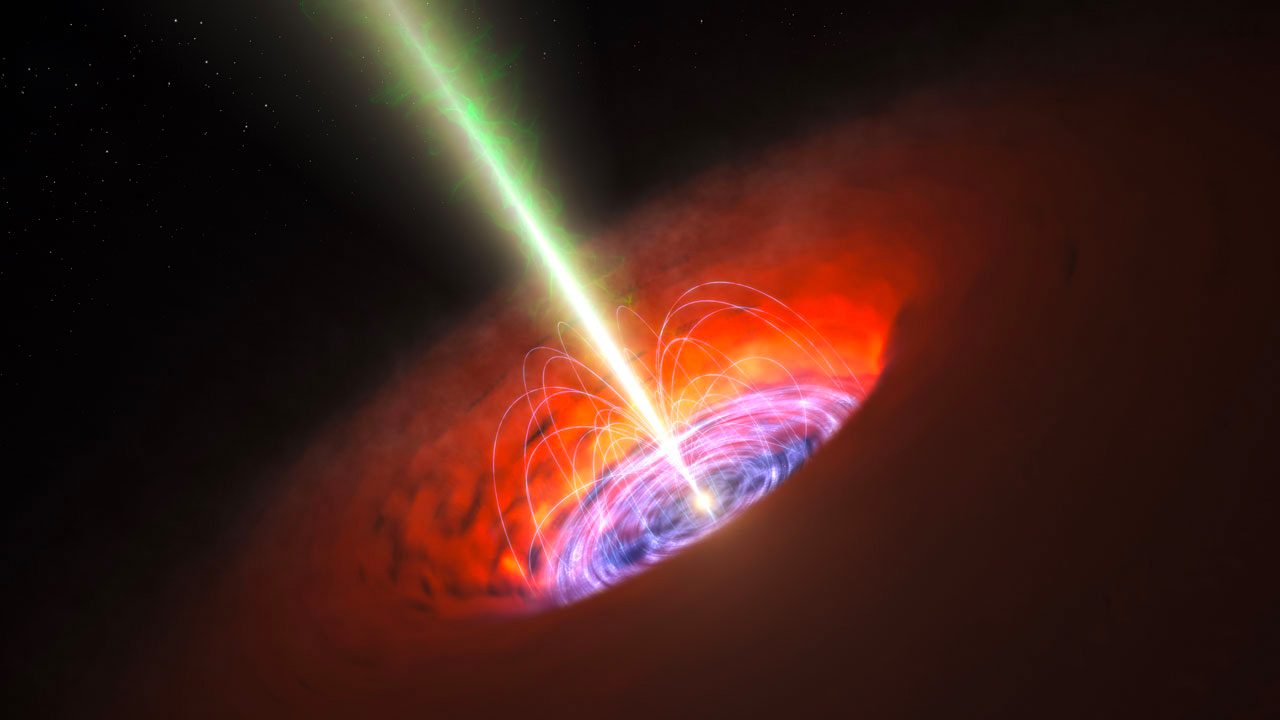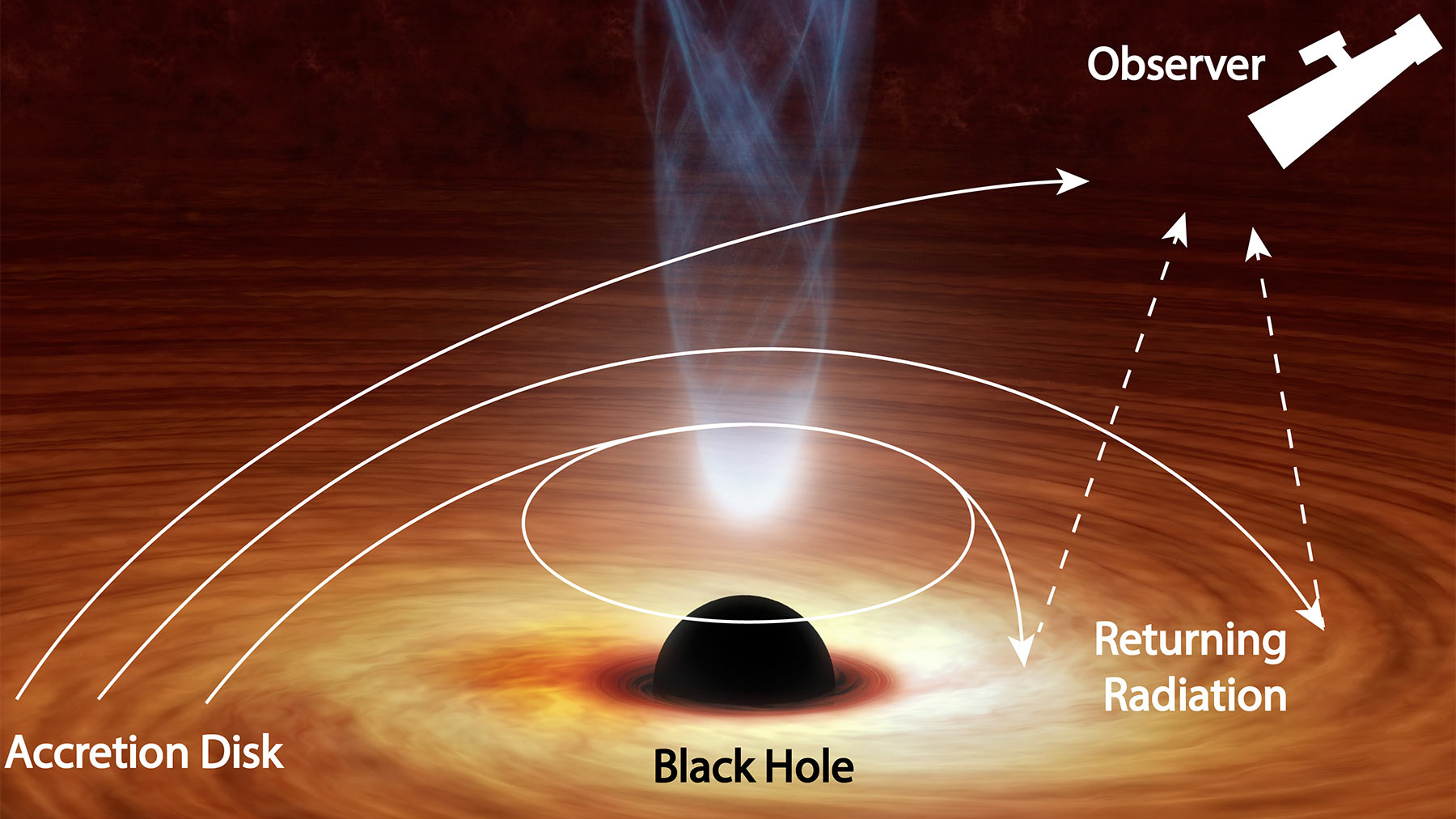Black hole bends escaping light 'like a boomerang'
Even light can't resist the pull of these irresistible cosmic objects.

Light escaping from a black hole may "boomerang" its way to freedom, new X-ray images reveal.
Researchers found this odd behavior while reviewing archival X-ray observations of a black hole that's approximately 10 times as massive as our sun. Located about 17,000 light-years from Earth, the black hole siphons material from a partner star; together, the black hole and star are known as XTE J1550-564.
Things can get pretty weird around a black hole. These exceptionally dense cosmic objects exert such a powerful gravitational pull that even light can't resist their attraction. And scientists recently found that light behaves even more strangely around a black hole than once thought. Light in a black hole's accretion disk — a spiraling, flattened cloud of dust and gas that circles the edges of a black hole — can sometimes escape into space. But the departing light from the XTE J1550-564 black hole didn't follow the predictable path. Instead of escaping directly from the disk, the light was instead pulled back toward the black hole and then reflected off the disk and away from the black hole "like a boomerang," researchers reported in a new study.
Related: Stephen Hawking's most far-out ideas about black holes
They modeled the black hole's accretion disk and its corona — a lower-density gas zone very close to the black hole — using data captured by the Rossi X-ray Timing Explorer, a now-defunct NASA satellite mission that investigated black holes, neutron stars and other X-ray emitting objects between 1995 and 2012.
"Typically, what we study is light that comes from that gas" — the corona — "and it bounces off of this disk that's spiraling toward the black hole," said lead study author Riley Connors, a postdoctoral researcher in physics at the California Institute of Technology's Cahill Center for Astronomy and Astrophysics in Pasadena, California.
Normally, the team studies light "coming from that corona and hitting the disk, bouncing off, and then arriving at our telescopes. That's something we've been studying for a long time," Connors told Live Science.
Sign up for the Live Science daily newsletter now
Get the world’s most fascinating discoveries delivered straight to your inbox.
This time, however, some of the light bouncing off the black hole's disk appeared to originate in the disk itself rather than in the corona; it was then dragged back toward the black hole before bouncing away.
"The thing that we found, that was predicted in the 1970s, is that you could see light that comes from the disk bent all the way back onto itself," Connors said.
Light from different regions around the black hole has distinctive X-ray signatures that tell scientists where the light came from. When the study authors looked at the data for XTE J1550-564, they saw light that was reflected from the black hole but had emission "fingerprints" that didn't quite match those in light that came from the corona, Connors said. The researchers then turned to computer models to explain the anomaly.

Putting a new spin on black holes
This discovery could help scientists confirm other elusive aspects of black holes, such as how fast they spin. Researchers already understand how an accretion disk around a black hole behaves. By adding this boomeranging light to their computer models, astrophysicists can then calculate a black hole's rotation speed based on how much of the light is bending and bouncing back, Connors explained.
"It's perhaps a more reliable way for us to measure how fast the black holes are spinning," he said. '"
Though this phenomenon has been documented to date only in the XTE J1550-564 system, this is likely not the only black hole where light performs these unusual gymnastic feats, Connors said.
"We're starting to look at data from other black holes; we have data from multiple X-ray satellites for dozens of these systems in our own galaxy," he said. "We think that we should see this in many other sources."
The findings were published online March 20 in The Astrophysical Journal.
- Twisted physics: 7 mind-blowing findings
- The biggest black hole findings of 2019
- The 12 strangest objects in the universe
Originally published on Live Science.
OFFER: Save 45% on 'How It Works' 'All About Space' and 'All About History'!
For a limited time, you can take out a digital subscription to any of our best-selling science magazines for just $2.38 per month, or 45% off the standard price for the first three months.

Mindy Weisberger is an editor at Scholastic and a former Live Science channel editor and senior writer. She has reported on general science, covering climate change, paleontology, biology and space. Mindy studied film at Columbia University; prior to Live Science she produced, wrote and directed media for the American Museum of Natural History in New York City. Her videos about dinosaurs, astrophysics, biodiversity and evolution appear in museums and science centers worldwide, earning awards such as the CINE Golden Eagle and the Communicator Award of Excellence. Her writing has also appeared in Scientific American, The Washington Post and How It Works Magazine. Her book "Rise of the Zombie Bugs: The Surprising Science of Parasitic Mind Control" will be published in spring 2025 by Johns Hopkins University Press.











